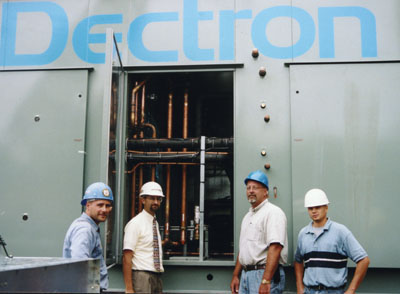
The Grand Haven project is the culmination of many original HVAC design concepts developed and implemented at previous indoor swimming pool projects by an engineering team from GMB Architects-Engineers, Holland, Michigan. Led by project mechanical engineer, James Harrison, GMB's innovations at Grand Haven include a unique split return air design. Additionally, the school district realized a substantial cost savings in labor and materials because GMB specified one of the world's largest dehumidifiers, which was custom manufactured by indoor air quality equipment manufacturer, Dectron Internationale, Roswell, Ga.
"One of our primary goals in the construction of the aquatic center was to have a facility that not only met the needs of our swimming and recreation programs, but also created a comfortable healthy environment for spectators," said Rick Kent, superintendent, Grand Haven Area Public Schools. "Our aquatic center has exceeded all these goals."

GMB broke tradition on other natatorium HVAC design concepts as well. Typically an indoor pool dehumidifier is in a mechanical room or rooftop location. At Grand Haven however, the dehumidifier is located outside at ground level to save upwards of $30,000 in mechanical room square footage and eliminate what may have resulted in an unsightly installation on the facility's aesthetic, barrel-shaped roof. Since part of the return air is underground in the pool area, Rite-Way Plumbing & Heating, Grand Rapids, Michigan, kept the return ductwork underground for aesthetic purposes en route to the dehumidifier.
The underground return air enters the dehumidifier via a base configuration and curb plenum-a custom modification specified by GMB. The challenge with an underground duct installation, according to Larry Heemstra, project manager, Rite-Way Plumbing & Heating, is digging the trench deep enough and then structurally supporting the walls to protect workers against dangerous cave-ins.

"I approached Paul McWafters (sales engineer at MacAire Inc., a Grand Rapids, Michigan-based manufacturer's representative for Dectron) to see if Dectron could custom build one really large unit and they came through," said Harrison.
GMB also designed a supply air distribution system that is visually unnoticeable because it follows the contours of the natatorium's architectural, barrel shaped ceiling. While the ductwork adds an aesthetic touch, sheet metal subcontractor, Superior Sheet Metal, Rockford, Michigan, found it challenging to install. Manufactured by Eastern Sheet Metal, Cincinnati, the galvanized and epoxy-coated spiral ductwork needed dozens of elbows ranging from 15 to 22-degrees to maintain a constant 12-inch gap along the contoured ceiling. "Installing the ceiling ductwork was very challenging and required super accurate field measurements," said Jerry Marculis, estimator/coordinator, Superior Sheet Metal.
While the Dry-O-Tron dehumidifies and heats the pool water, it also reduces the space heating load in winter via efficient heat recovery from the exhaust air and preheating of the outdoor air. Space heating is handled by the building's hot water heating system comprised of a two Lochinvar Corp., Nashville, Tennessee 2,618 mbh input boilers that supply a Taco Inc., Cranston, R.I., 1,575 mbh, 158 gpm secondary heat exchanger via a 1.5 hp Taco pump.
Besides the main pool, the facility also has a separate 2,000-square-foot therapy pool room that features a 15-foot-high, 25-foot-wide wall of windows. Keeping the windows free of condensation was another design challenge for GMB. Neither the area between the ceiling and the windows nor a pool deck diffuser system would provide ample window coverage. Instead, air was supplied from two 12-inch round column ducts that appear aesthetically as support columns on each side of the windows.
Even though Grand Haven is a small town of 15,000 people, it now has a big time pool that attracts many local swimming programs and competitions.
For more information, contact Dectron Inc. at 770-649-0102 or go to www.dectron.com.
Publication date: 02/19/2001

Report Abusive Comment